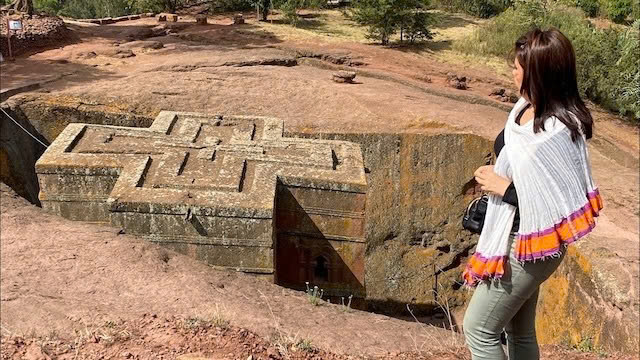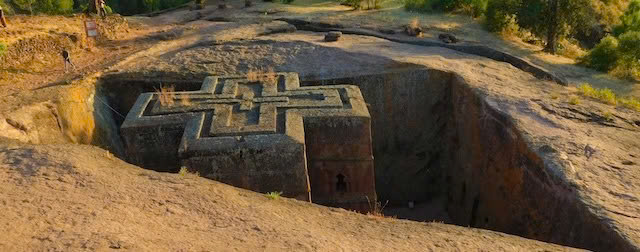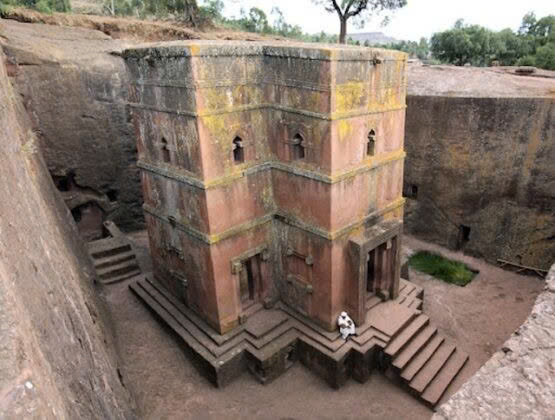Deep within the highlands of Ethiopia lies one of the world’s most extraordinary religious monuments—a church that defies conventional understanding of medieval architecture. The Church of Saint George in Lalibela stands as a testament to human determination and divine inspiration, carved entirely from living volcanic rock in a feat that continues to baffle engineers and historians today.
A Vision Carved in Stone
The Divine Dream of King Lalibela
In the 12th century, King Lalibela of Ethiopia experienced a prophetic vision that would forever change the landscape of Christian architecture. According to ancient legends, angels appeared to him in dreams, revealing plans for a sacred complex that would transform his kingdom into a “New Jerusalem.” What emerged from this divine inspiration was not just another church, but an entire underground cathedral hewn from a single massive block of volcanic stone.

The Church of Saint George, known locally as Bete Giyorgis, represents the culmination of this heavenly vision. Unlike any structure built before or since, this architectural wonder was carved from the top down, with artisans methodically chiseling away tons of rock to reveal the perfect cruciform cathedral hidden within.
An Engineering Miracle Lost to Time
The construction methods employed remain one of history’s greatest puzzles. How did 12th-century builders achieve such precision without modern tools? The smooth walls, perfect angles, and intricate decorative elements suggest sophisticated planning and execution that challenges our understanding of medieval capabilities.

Some scholars theorize that master craftsmen worked for decades using only basic chisels and hammers, while others propose the existence of advanced architectural knowledge that has since been lost. The church’s seamless integration into the surrounding rock face, complete with elaborate drainage systems and hidden passages, speaks to an engineering sophistication that rivals modern construction techniques.
The Sacred Geometry of Faith
A Cross Carved into the Earth
The Church of Saint George’s most striking feature is its perfect cruciform shape, visible only from above. This cross, carved deep into the earth, creates a powerful symbol that can be seen as representing Christ’s descent into the underworld and subsequent resurrection. The church literally emerges from the earth like a stone flower, its roof level with the surrounding ground.

Every architectural element carries profound spiritual meaning. The narrow passages that wind around the structure mirror the spiritual journey of pilgrimage, while the precise proportions reflect sacred geometric principles found in biblical descriptions of holy temples.
Living Heritage in Stone
Today, the church continues to serve its original purpose as a place of worship for Ethiopian Orthodox Christians. During major religious festivals, thousands of white-robed pilgrims gather in the stone courtyard, their prayers echoing off the ancient walls in scenes that transport visitors back eight centuries.

The interior chambers, carved with the same meticulous attention to detail as the exterior, house sacred artifacts and religious paintings that have been preserved by the cool, stable environment within the rock. Candlelight flickers across carved biblical scenes, creating an atmosphere of mystical reverence that has remained unchanged since medieval times.
Video
The Enduring Mystery
Questions Without Answers
Despite extensive archaeological study, the Church of Saint George guards its secrets jealously. No definitive evidence exists of the tools used in its construction, the number of workers involved, or even the exact timeline of its completion. Carbon dating has proven difficult due to the nature of the volcanic rock, leaving much of the church’s history open to interpretation.

The precision of the carving suggests the involvement of master architects and engineers, yet no records exist of such expertise in 12th-century Ethiopia. This has led some researchers to speculate about possible connections to Byzantine or other foreign architectural traditions, though the church’s unique design bears little resemblance to contemporary structures elsewhere.
A Living Wonder of the World
The Church of Saint George stands today as more than just an archaeological curiosity—it represents the culmination of human ambition, spiritual devotion, and artistic achievement. Protected as a UNESCO World Heritage Site, ongoing conservation efforts ensure that future generations will continue to marvel at this extraordinary fusion of faith and craftsmanship.

In an age of steel and glass, this ancient stone cathedral reminds us that the most enduring monuments are often those carved not just from rock, but from the bedrock of human belief and determination. The Church of Saint George remains a bridge between heaven and earth, a miracle in stone that continues to inspire wonder nearly a millennium after its creation.

